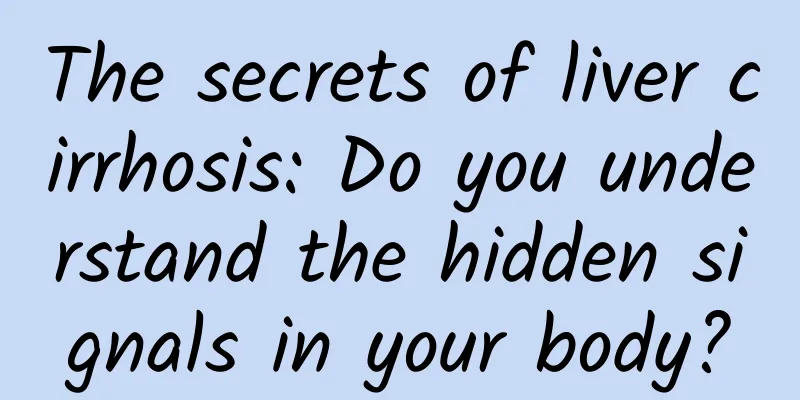The secrets of liver cirrhosis: Do you understand the hidden signals in your body?

|
Author: Jin Bo, Chief Physician of the Fifth Medical Center of the General Hospital of the Chinese People's Liberation Army Reviewer: Ji Dong, Chief Physician, Fifth Medical Center, PLA General Hospital Liver cirrhosis, a hidden and serious disease, is quietly threatening the health and lives of many people. It is not only a hardening process of the liver, but also a warning light for the health of the whole body. As the disease progresses, patients with liver cirrhosis may encounter a series of complex and varied symptoms. These symptoms are like distress signals from the body, reminding us that we must pay enough attention and care. Today, we will deeply analyze the deep reasons behind the different symptoms of liver cirrhosis. By understanding the mechanisms behind these symptoms, we can not only more accurately identify the early signs of liver cirrhosis, but also take more effective preventive measures and care methods in daily life. 1. What are the clinical manifestations of cirrhosis? Clinically, cirrhosis is divided into compensated and decompensated cirrhosis according to whether complications such as ascites, upper gastrointestinal bleeding or hepatic encephalopathy occur. 1. Compensated cirrhosis: There are no symptoms or mild symptoms in the early stage, with fatigue, poor appetite, and low fever as the main manifestations, which may be accompanied by abdominal distension, nausea, aversion to greasy food, upper abdominal pain, and diarrhea. Symptoms often occur due to fatigue or concomitant diseases, and can be relieved after rest or treatment. 2. Decompensated cirrhosis: mainly systemic multi-system symptoms and signs caused by decreased liver function and portal hypertension. (1) Clinical manifestations of liver dysfunction: ① Systemic symptoms. Fatigue, lack of energy, poor nutritional status. ② Gastrointestinal symptoms: loss of appetite, abdominal distension, diarrhea, abdominal pain. ③ Bleeding and anemia. Nosebleeds, bleeding gums, petechiae, ecchymoses or bleeding spots on the skin and mucous membranes. ④ Endocrine disorders. Sexual dysfunction, infertility, male breast development, hair loss, menstrual disorders, amenorrhea, etc. Some patients may develop spider nevi and liver palms. (2) Clinical manifestations of portal hypertension: splenomegaly, establishment and opening of collateral circulation, esophageal and gastric varices, abdominal wall varices, ascites, etc. Figure 1 Copyright image, no permission to reprint 2. Why do patients with liver disease have dark or black complexions? What are the characteristics of liver disease? The dull complexion is mostly because patients with cirrhosis are in a state of liver dysfunction for a long time. The liver cannot function well, causing the patient's liver to have problems in inactivating estrogen in the body. Estrogen in the blood continues to accumulate, and the increased estrogen can cause the inhibitory effect of thioamine on tyrosinase in the body to weaken, increasing the amount of tyrosine converted to melanin, causing the patient's skin color to darken and the skin and complexion to become darker. In addition, patients with chronic liver disease have endocrine dysfunction, which affects pigment metabolism and causes pigment deposition in the skin. Patients with cirrhosis also have adrenal insufficiency, and the liver cannot metabolize melanocyte-stimulating hormone (MSH) secreted by the anterior pituitary gland, which increases melanin secretion. Characteristics of liver disease include gradual darkening, blackening, lusterlessness, poor elasticity, dryness, roughness, and even a "bronze" face. In some patients, the area around the eyes is particularly dark, a bit like "panda eyes." In some patients, tiny capillary dilation occurs on the face or tip of the nose, like a fine grid, which is more common in patients with chronic hepatitis and cirrhosis. 3. Why do patients with liver cirrhosis have bleeding gums? How to prevent it? Figure 2 Copyright image, no permission to reprint 1. Causes of bleeding gums: Patients with cirrhosis have decreased liver function, which reduces the coagulation factors synthesized by the liver, leading to decreased coagulation function; in addition, splenomegaly and hypersplenism cause the spleen to "eat" a large number of platelets, leading to thrombocytopenia. 2. Ways to prevent bleeding gums (1) Develop good oral hygiene habits, brush your teeth in the morning and evening, avoid using a hard-bristled toothbrush or excessive force when brushing your teeth. Use a soft-bristled toothbrush instead. The correct way to brush your teeth is to brush your teeth vertically with moderate force to prevent irritation to the gums and bleeding. (2) Rinse your mouth frequently with clean water after each meal and before going to bed. If you have bad breath, leukoplakia, ulcers or dry mouth, it is recommended to use light salt water, 3% sodium bicarbonate mouthwash or biopolysaccharide antibacterial gargle sol (Shu Tai, etc.) to relieve oral discomfort. (3) Do not use toothpicks to pick your teeth. It is recommended to use dental floss instead. This is because the tip of a toothpick is sharp and not flexible, which can easily damage the gums and cause bleeding. This not only allows bacteria to enter the teeth and cause gingivitis, but also makes it difficult to stop bleeding for patients with poor coagulation function. (4) Eat a light diet on a regular basis and avoid eating raw, cold, spicy, or greasy foods. Take appropriate amounts of fresh fruits rich in vitamin C, such as oranges and kiwis. Figure 3 Copyright image, no permission to reprint 4. Why do patients with cirrhosis and high jaundice have itchy skin? What should be paid attention to in nursing? Skin itching is one of the common symptoms of jaundice patients. The main cause of skin itching is that bile salts in the blood stimulate the peripheral sensory nerves of the skin. In addition, the skin of patients with cirrhosis is dry, rough, and has poor elasticity. Therefore, the following 4 points should be achieved in daily life. 1. Trim your nails and avoid scratching your skin to avoid breaking the skin, which may lead to skin ulceration and secondary infection. 2. Wear cotton, soft, loose clothing, change and wash underwear frequently, and keep bed sheets clean, soft, flat, and dry to reduce skin irritation. 3. When bathing, be careful not to use water temperatures that are too high, avoid using soap or other alkaline or irritating soaps and shower gels, and apply gentle moisturizer all over your body after bathing to keep your skin moisturized. 4. When the skin itching is unbearable, you can rub it with your fingertips to relieve the discomfort; in severe cases, you can apply calamine, liquid dressings or other anti-itching ointments externally, or you can take oral chlorpheniramine maleate tablets and other drugs to relieve itching as prescribed by the doctor. Figure 4 Copyright image, no permission to reprint |
>>: To relieve constipation in children, choose laxatives carefully
Recommend
What causes dysmenorrhea in girls?
Most women experience dysmenorrhea during menstru...
Can pregnant women drink brown sugar water in 6 months?
Pregnant women are advised not to drink brown sug...
Why do you do a curettage during menstruation?
Curettage is a very scary surgical treatment. For...
Pregnant woman eats 40 cherries at once
Pregnant women are the ones who need nutritional ...
I can't see the fetal heartbeat during the ultrasound of two months of pregnancy
Women should undergo regular physical examination...
What is the difference between telecom fiber and broadband? How to measure the speed of telecom fiber broadband?
Home broadband generally uses ordinary network ca...
Did you take anti-inflammatory drugs in early pregnancy?
In life, some women receive anti-inflammatory dru...
The truly effective breast enhancement method
Full breasts can not only make the body shape mor...
When should I wear myopia glasses? When should I take them off?
Myopia degree is below 300 degrees: wear it when ...
How can women reduce belly fat?
Every woman wants a flat belly, which can make a ...
What if the test strip shows no pregnancy but I don't have my period?
Generally, when a woman misses her period, the fi...
Which sanitary napkin is good? Authoritative experts teach you how to choose!
As we all know, women will use the bathroom durin...
If you have diarrhea after eating, you may have irritable bowel syndrome
Author: Lou Wenjia Peking Union Medical College H...
What is the cause of curd-like leucorrhea?
Leucorrhea is a vaginal discharge that every woma...
The advantages and disadvantages of drinking brown sugar water during menstruation
Many women will feel some abdominal pain during m...









